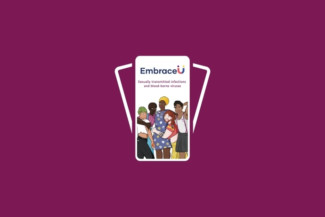This language guide may help you understand some words that are commonly used when reading about sexual health, sexually transmissible infections (STIs) and blood-borne viruses (BBVs) for trans, gender diverse and non-binary people.
We have tried to make sure that the terms EmbraceU uses aren’t excessively gendered and instead affirm that bodies are diverse and valid. Throughout the site we use medical terms to describe body parts and sexual activity, so it is clear what we are referring to.
For ease of use the language guide is available in full as both a pdf via the link above, and as text below. You may download and print the language guide for personal use.
Please note: this is not a static document and will evolve over time. Please email [email protected] or use our feedback form if there are other words you think we should be including in the language guide.
Contents
— Anatomy
— Safer Sex
— STIs and BBVs
— Trans and gender diverse terms
Anatomy
Throughout EmbraceU we have decided to use medical words (like mouth, anus, vulva, vagina, and penis) to describe body parts, so that it’s easy for people to know what we are referring to. Saying this, we understand people use a variety of words to refer to their body parts, and we encourage you to use whatever words feel most comfortable for you!
If you’re a clinician, make sure to check in and use the words most comfortable for the person.
Some of the terms people might choose to use include:
- Genitals, parts, junk, bits, clit, girldick, T-dick, cock, dick, front hole, vag, boypussy, clitdick, balls, testes
- Back hole, arse, butt, bussy
- Breasts, chest, breast tissue, boobs, tits
Safer Sex
Sex can mean different things to different people. Sex can include vaginal, anal, oral, hand jobs or fingering (hand to genitals), and more! Because there isn’t just one type of sex, there are different options for safer sex. These are some terms that you might come across when we talk about safer sex.
Antiretroviral: or ART, can refer to medication taken by people with HIV to reduce the amount of the virus in the body and restore the immune system. There are also antivirals, which can be used to treat viral infections like hepatitis B or hepatitis C.
Asymptomatic: When someone has an infection or illness but does not show or experience symptoms, they are asymptomatic. A lack of symptoms is often the most common symptom of an STI.
Barrier methods: Safe sex methods that involve a physical barrier between people, such as the internal condom, external condom or dental dam. These methods stop skin-to-skin contact and fluid exchange, which prevents STI/BBV transmission.
Consent: Sexual consent is the giving and receiving for permission to engage in sexual activity without threat or coercion. Consent must be freely given, specific and informed. It can be withdrawn at any time and is an ongoing conversation; not just at the beginning. Someone cannot legally consent if they are underage, drunk, drugged, unconscious, asleep, threatened or forced.
Contraception: The use of artificial methods to prevent pregnancy. Different methods of contraceptives are available to suit different bodies, and different needs. Some trans, gender diverse and non-binary people use hormonal contraceptives to stop or control their menstruation.
Contraceptive implant: The hormonal implant is a small rod the size of a matchstick that prevents pregnancy for up to three years. A trained doctor or nurse inserts the implant under the skin of the upper arm. It releases the hormone progestin to prevent pregnancy and is one of the most effective birth control methods available.
Contraceptive injection: The contraceptive injection is a hormonal contraceptive used to prevent pregnancy, but not STIs/BBVs. The injection of the hormone progestin will prevent pregnancy for three months and is also sometimes used in hormone replacement therapy.
Dental Dam: A thin, square piece of latex that helps prevent the spread of STIs/BBVs when placed over the vulva or anus during oral sex. It is a barrier method that prevents skin-to-skin contact and the transfer of fluids.
External Condom: The most common form of barrier method, the condom is a thin sheath of latex (or other materials) that covers the penis during sex (oral, vaginal, anal) to reduce the risk of STIs, BBVs, and pregnancy. Sometimes referred to as the male condom or just the condom.
Gloves: Latex and nitrile gloves can be a useful barrier method for sex to prevent STI/BBV transmission, particularly during manual sex such as fingering.
Hormonal contraceptives: Birth control methods that use hormones such as estrogen and progesterone to prevent pregnancy. These include the implant, the hormonal IUD, the pill and the contraceptive injection. They can also be used to control and manage periods and aid with body dysphoria.
Internal Condom: A soft latex pouch with rubber rings on each end. It is inserted into the vaginal canal to help prevent pregnancy and the spread of STIs and BBVs during penetrative sex. Sometimes referred to as the female condom.
Intrauterine device (IUD): An anchor-shaped device placed inside the uterus which either uses hormones or copper to prevent pregnancy. It is a safe, long-term, reversible and highly effective form of birth control.
Lube / lubricant: Slick products used to increase slipperiness and reduce friction during sex. Water and silicone-based lubes should be used with condoms. Oil-based lube should not be used with condoms as it can weaken and damage latex.
Oral sex: Sex involving the mouth and genitals, including cunnilingus (oral to vaginal), anilingus (oral to anus) and fellatio (oral to penis).
Post-exposure prophylaxis (PEP): Medicine used to prevent HIV transmission if taken as soon as possible after exposure to HIV (within 72 hours). It can be accessed at hospitals and some sexual health clinics. Find out more at www.getpep.info.
Pre-cum: The small amount of fluid (sometimes containing sperm) that may come out of the penis during sexual excitement before ejaculation.
Pre-exposure prophylaxis (PrEP): An antiviral medication taken daily before potential HIV exposure to reduce the risk of getting HIV.
Prostate: A gland that produces seminal fluid, a component in semen which helps sperm move. The prostate can be very sensitive to the touch, and many people enjoy stimulating the prostate for sexual pleasure.
Pulling out / pull-out method: Pulling the penis out of the vagina before ejaculation. Also called withdrawal, it has a lower effectiveness than other forms of contraception.
Rimming: Also known as anilingus, it is the use of mouth to pleasure someone’s anus. Rimming can include licking, tonguing, sucking, kissing or any other oral act.
Sexual fluids: Discharge from the genitals or anus, often associated with sexual activity, including semen, pre-cum, anal mucus, vaginal discharge, arousal fluid or fluids from squirting.
Vaginal discharge: People with vaginas can experience fluid discharge at different points of sexual arousal or menstruation. Normal discharge can be thick or thin, clear, white or yellow when it dries on your underwear. It has a mild, not unpleasant smell. A change in discharge may indicate an infection.
Vaginal lubrication: When the vagina gets wetter and more slippery, which can aid penetration by fingers, toys and penises. This happens naturally with vaginal secretions and can be done with lube. Sometimes happens during sexual arousal, but not always.
STIs and BBVs
AKA Sexually Transmissible Infections and Blood-borne Viruses
Bacterial vaginosis (or BV): An inflammation of the vulva/vagina caused by a change in the balance of vaginal bacteria. It’s not an STI but can be caused by douching or having sex with a new partner.
BBV (blood-borne virus): A blood-borne virus (BBV) is a virus that is transmitted by blood or body fluids that contain blood. Example BBVs include HIV, hepatitis B and hepatitis C.
Candida: A yeast that causes vaginal yeast infections when it becomes overgrown. Yeast infections may also occur in the penis, scrotum, mouth and throat. Also known as thrush.
Chlamydia: The most common STI in Australia, caused by a bacteria and curable with antibiotics. Often asymptomatic and can lead to pelvic inflammatory disease, infertility and arthritis if left untreated.
Genital warts: Soft, skin-coloured growths on or near the penis/vulva/anus, caused by some types of HPV (see below). They are usually painless but may itch. Treatable but not curable.
Gonorrhoea: A bacterial STI that’s easy to treat, but if it isn’t treated it can lead to infertility, arthritis and heart problems. It often has no symptoms. It is also known as ‘the clap’ or ‘the drip’.
Hepatitis B: A viral infection that can be transmitted through sexual contact or contact with blood. It can lead to serious liver problems in some people if left untreated. Hepatitis B is preventable by vaccine and can be treated.
Hepatitis C: A viral infection that is transmitted through contact with blood. It is curable but can lead to serious liver damage if left untreated.
Herpes: Herpes virus simple 1 and 2 are common STIs which can be transmitted through skin-to-skin contact and sexual contact. Herpes can make blistery sores show up on and around the genitals, anus and mouth. It has no cure, but there is treatment available when sores appear.
HIV (human immunodeficiency virus): A virus that attacks the immune system. It is spread through sexual contact and blood-to-blood contact. HIV is treatable but progresses into AIDS (Acquired Immune Deficiency Syndrome) if left untreated.
HPV (human papillomavirus): A common virus that is spread through skin-to-skin contact and sexual contact. There are over 100 different types, some causing cancers and warts and others which cause no symptoms. A vaccine is available for the serious strains.
PID (pelvic inflammatory disease): An infection in the uterus, fallopian tubes, and/or ovaries that can lead to infertility, ectopic pregnancy and chronic pain. It’s often caused by untreated STIs like gonorrhoea and chlamydia.
Pubic lice: A type of lice that can be sexually transmitted through close contact. They are not the same as head lice. Pubic lice attach to pubic hair and can cause intense itching of the genitals. Also known as crabs.
Scabies: An itchy skin condition caused by the scabies mite. It can be passed through skin-to-skin contact, including sex. Scabies isn’t dangerous and can be cured but can be irritating.
Shigella: This is a bacterial intestinal infection which can be transmitted by ingesting faecal matter and has been noted to transmit through oral to anal sex (rimming). It can be prevented through the use of dental dams.
STI (sexually transmissible infection): An infection which is passed from one person to another during sex – be it vaginal, anal, or oral, or sexual skin-to-skin contact.
Syphilis: A bacterial STI that is cured with antibiotics but can cause permanent damage if left untreated. Various parts of Australia are currently experiencing an outbreak of syphilis.
Trans and Gender Diverse Terms
AFAB/PFAB: Assigned female at birth or presumed female at birth. (See ‘presumed at birth’ definition)
AMAB/PMAB: Assigned male at birth or presumed male at birth. (See ‘presumed at birth’ definition)
Agender: Refers to someone who does not experience or identify with having a gender or having no gender to express. They may refer to themselves as genderless.
Brotherboy: A term used by some Aboriginal and Torres Strait Islander people to describe gender diverse people who have a male spirit and take on male roles within the community. Brotherboys often have a strong sense of their cultural identity. The spelling and use of this term may differ from area to area, and in some places, it has different meanings and may be used to refer to a friend.
Cisgender (cis): A term used to describe people whose gender is the same as what was presumed for them at birth (male or female).
Cissexism: This refers to the cultural norm that rejects or pathologises gender identities that don’t align with presumed gender at birth. Cissexist ideology invalidates trans and non-binary genders, believing that gender is determined at birth solely based on sex characteristics and is binary.
Cisnormativity: The assumption that everyone is cisgender. This may result in misgendering, including using the wrong pronouns, or designing services, products, or campaigns that assume everyone is cis.
Gender: An internal sense of self that is a part of a person’s social and personal identity. Some examples are man, woman, non-binary, agender, and genderqueer.
Gender diverse: An umbrella term used to describe genders beyond heteronormative binary framework, or beyond presenting as either male or female.
Gender affirmation (gender transition): Trans and gender diverse people may choose to take steps to live authentically in line with their gender. It may involve social steps (e.g. changing name, or pronouns, wearing different clothes), medical steps (e.g. hormones, surgery) or legal steps (e.g. updating birth certificate or licence). There is no one right way for a person to affirm their gender.
Gender binary: The idea that there are only two categories of gender (male and female) that are mutually exclusive and different from each other.
Gender dysphoria: Refers to the distress or unease some trans and gender diverse people experience when their gender and body don’t align or when they are misgendered. Not everyone experiences it, and experiences vary from person to person.
Gender euphoria: Refers to the happiness and joy of living openly and proudly as one’s gender. It describes feeling affirmed and congruent with their gender.
Genderqueer: A term used by some people who reject notions of static categories of gender. Some people use genderqueer, gender non-conforming and non-binary interchangeably and others don’t. Some people use the term to identify their gender as non-normative, e.g. someone could identify as both non-binary and genderfluid.
Heteronormativity: Refers to the default assumption held by society that everyone fits into one of the two binary genders (male or female) and is heterosexual, or ‘straight’. It assumes that the ‘norm’ is binary, usually cisgender, who are attracted to the opposite sex and anything outside of this is ‘abnormal’.
Hormone Replacement Therapy (HRT): This consists of taking hormones and/or blocking existing hormones in the body.
Intersex: Intersex people have innate sex characteristics that don’t fit medical and social norms for female or male bodies, and that may create risks or experiences of stigma, discrimination and harm.
Misgendering: This term is used when someone uses language (to address another person) that does not match their gender, which in some instances may cause dysphoria for the individual. This may include using the wrong name, pronoun or title for someone. In line with this, there are terms like ‘deadnaming’ which are used when someone is addressed with a name they no longer use.
Non-binary: This is an umbrella term for any number of gender identities that sit within, outside of, across or between the spectrum of the male and female binary. A non-binary person might identify as gender fluid, trans masculine, trans feminine, agender, bigender etc.
Passing: A trans person who “passes” is someone who is viewed as their affirmed gender by society (without being identified as trans). Passing does not determine the legitimacy of a person’s gender. This term should be used with caution and only used by trans and gender diverse people.
Pronouns: Pronouns are used as a way to identify a person without using their name. There are gendered pronouns like he/him and she/her, neutral pronouns such as singular they/them, and neo-pronouns such as ze/zir, though others can also be used.
Presumed at birth: The gender you are presumed to be at birth is what the doctor says you are when they see you after being born. Everyone is presumed to be a certain gender at birth.
Stealth: A trans person who does not openly disclose their gender history and is viewed as their affirmed gender by society. If a trans person decides to be ‘out’ or ‘stealth’, it is up to them alone, and the term is most appropriate if used in-community.
The term stealth is also sometimes used to refer to when someone says they will use a condom during sex but removes it during sex without telling the other person. When this happens, the sex is no longer consensual, because to give consent everyone must be fully informed.
Sistergirl: Sistergirl is a term used by some Aboriginal and Torres Strait Islander gender diverse people that have female spirits and take on female roles within the community, including looking after children and family. Many sistergirls live a traditional lifestyle and have strong cultural backgrounds. The spelling and use of this term may differ from area to area, and in some places, it has different meanings, and may be used to refer to a friend.
Transgender (trans): People whose gender is different to what was presumed for them at birth. Some examples are trans men, trans women, and non-binary people.
Related Resources
Inclusive practice tips
Language, Professionals

Sexually transmitted infections and blood-borne viruses brochure
Downloads, Medical

Sexual health testing video
Medical, Video

